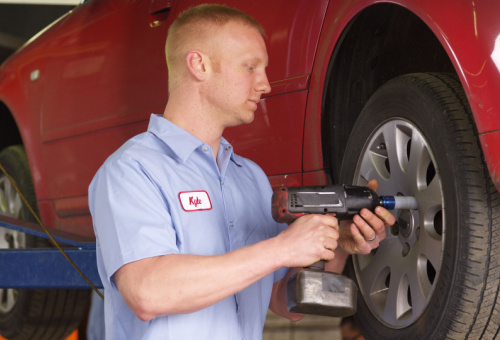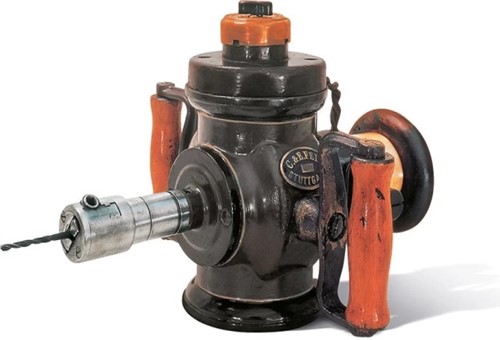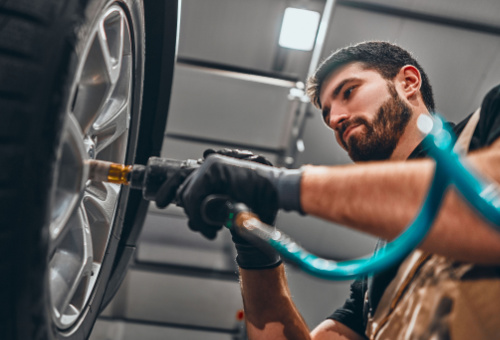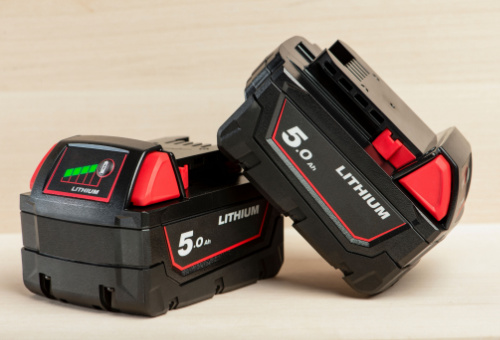
Do you own and use cordless power tools, and have they made your working life easier? Many among us will no doubt answer “yes” to both questions, but some among us may have reservations about the benefits of laying out significant amounts of cash just to be rid of the cumbersome air hoses that feed their pneumatic tools with compressed air. If you fall into the first group, this guide may be preaching to the converted, but if you fall into the second group, this guide may just change your mind about how cordless tools could make your life easier. Regardless of which group you fall into, though, there are probably some things you did not know about cordless tools, but before we get to specifics, let us consider-

Image source: https://fein.com/fileadmin/MediaDatabase/global/images/teaser/history/bohrer%401920.jpg
If it is true that the advent of power tools has revolutionised the way we work, then we have been in a near-constant state of revolution since 1895*, which was when the first portable electric drill (shown above) was developed in Germany. This drill ideally required two people to operate it safely, but by 1917, the US-based Black & Decker tool company had invented a portable electric drill that featured a pistol grip and trigger switch that made single-handed operation of power drills possible. This development set a new standard in the design of power tools; a standard that all manufacturers of power tools still follow in the design of most portable power tools.
* Depending on the source consulted.
The next major development in the design of portable power tools came in 1961 when Black & Decker developed a cordless power drill, which was followed in the mid-1960s by a cordless, zero-impact wrench that saw service with NASA. This tool (among several others, including a cordless rock drill used on the Moon) saw service on many space missions because it could both undo and tighten fasteners in zero gravity conditions without spinning the astronaut using it around the spindle of the tool’s axis of rotation.
While the basic design features of portable power tools we use today date back to 1917, one of the biggest drawbacks of the cordless power tools that date from the period between 1961 and 2005, when lithium-ion batteries became available, was the limited capacity of nickel-cadmium and nickel-metal hydride batteries. We need not delve into the finer details of these battery chemistries here, but suffice to say that the combination of long charging times and the charge memories that these batteries developed often defeated the advantages of owning cordless power tools.
As a practical matter, the development of lithium-ion batteries represented arguably the single biggest advance in the evolution of cordless power tools because, unlike older battery technologies, lithium-ion batteries can be manufactured in any shape or size. This property of lithium-ion batteries makes it possible to design (almost) perfectly balanced power tools because the shape and weight of the battery could now be incorporated into the overall design of a power tool to act as a counterweight to absorb some of the rotational forces some modern cordless power tools generate.
Limited space precludes a comprehensive discussion of other major advances in the development of cordless power tools. Nonetheless, suffice to say that the combination of high energy density batteries, ease of use and affordability has brought about a cordless power tool for every conceivable job not only in the industrial, construction, and car repair environments, but also in the DIY home and car maintenance markets.
However, from our perspective as mechanics, cordless power tools are not created equal but before we get to the specifics of what makes any given cordless power tool “better” than any other cordless power tool, we need to discuss-

Anyone who has worked with both pneumatic and cordless power tools in the car repair industry will admit that although cordless tools are generally easier to use than pneumatic tools, pneumatic tools do not only still have a legitimate place in car repair workshops, but pneumatic tools also greatly outperform cordless tools in terms of-
Reliability / durability
If you have no or little experience with pneumatic tools, you may not realise that with minimal care and maintenance the useful lifespan of the pneumatic power tools that we as mechanics use(d) the most, such as impact wrenches, ratchets, screw and nut drivers, drills, and grinders of all kinds is typically measured in decades.
This was, and remains true simply because pneumatic power tools have far fewer moving parts than cordless tools. Moreover, what moving parts pneumatics tools do have only require a drop of oil in their air supply to operate reliably for decades, but note that this is not the same as saying that cordless tools are inherently unreliable and prone to regular failures.
However, the fact is that the heavy demands of a professional environment such as a busy tyre fitment centre places on the electric motors and electronics of cordless tools often translate into useful life spans that rarely, if ever, match those of pneumatic power tools. Note that this refers to the useful life of the tool itself, and not to their lithium-ion batteries that typically do not last beyond about 2000 charge/discharge cycles, which brings us to-
Torque control
Although pneumatic tools like impact wrenches often only have a “Forward” and “Reverse” setting, experienced(!) users of these tools will agree that it is possible to achieve a large measure of tightening torque control by "feathering" the trigger. Moreover, if the air pressure and supply are stable and/or constant, it is possible to obtain repeatable torque control over multiple similar fasteners, such as wheel nuts/studs.
Off course, feathering a trigger switch can never replace the use of a properly calibrated torque wrench to fasten wheel nuts/studs, but that is somewhat beside the point. The point is that since cordless tools’ torque output often depends on their batteries’ state of charge, it is sometimes very difficult to achieve repeatable tightening torque control over the discharge cycle of a cordless tools’ battery.
The cons of pneumatic power tools
Despite their long service lives, pneumatic tools have some major drawbacks, the most pertinent of which are the need for a reliable air compressor installation, and an umbilical cord in the form of an often-cumbersome air hose to feed compressed air to the tool. Moreover, pneumatic tools are also noisy, and the combination of noise and dragging an air hose around a service bay often makes using a pneumatic tool challenging, so let us consider-
The word "evolution" is perhaps not the right word to describe the large-scale move from pneumatic tools to cordless systems. The word "uptake” would perhaps be more appropriate since the biggest driver behind the proliferation of cordless tools/systems was not the automotive industry’s need to find better tools, but the advent of lithium-ion batteries that largely eliminated the need for contractors to lug heavy air compressors and air hoses around construction sites.
One other major driver was the fact that a small army of DIY home repair enthusiasts and hobbyists of all stripes now had access to affordable power tools suited to almost every conceivable job that not only did not require compressed air to work, but could also often be used continuously for several hours on a single battery charge.
However, despite the large-scale adoption of cordless tools by especially the DIY market, the fact is that pneumatic tools will likely never be completely supplanted by cordless tools in industry and professional environments such as car and truck repair workshops. In the case of the thousands of car repair workshops that still rely on pneumatic tools, the large compressors and the sometimes-extensive pipe installations needed to feed compressed air to multiple pneumatic tools represent a significant capital outlay that would be wasted unless these assets were used productively.
The above describes the short version of the large-scale move from pneumatic tools to cordless tools, and some readers might find this aspect of cordless tools mildly interesting. However, from our collective perspective as mechanics, one particularly hugely interesting aspect of cordless power tools involves the sometimes hidden or obscured meaning of some of the terminology used to describe the performance of cordless tools. Let us start by discussing what is perhaps the most important (and often most misunderstood) aspect of cordless impact wrenches, in particular, this aspect being-
There are no standards or regulations in force anywhere in the world that prescribe how manufacturers of cordless impact wrenches must a) test the performance of their products, and b), which aspects of their tests (and their results) manufacturers must publish, which allows some manufacturers of cordless tools to publish incorrect or downright misleading performance values for their products.
Note, though, that this is not the same as saying that all manufacturers of cordless impact tools are out to dupe unsuspecting customers. Far from it: two leading manufacturers and suppliers of cordless equipment in Australia, Milwaukee and SP Tools, both publish similar categories of technical specifications for their products, which makes it easier to compare their products on a like-for-like basis.
Limited space precludes a comprehensive comparison of all the relevant technical specifications of all the products supplied by both Milwaukee and SP Tools, but we can do the next best thing, which is to focus on the published torque specifications for any given cordless impact tool made by both manufacturers, and explain what these values mean in the real world. Let us start with the most often-published torque values-
Working torque
Most manufacturers of cordless impact wrenches have adopted a kind of unofficial industry standard to test the overall performance and/or torque output of the products. In short, this test involves measuring the maximum amount of torque that can be achieved by the tool under test while tightening a fastener over 15 consecutive seconds. However, due to the extreme torque values some cordless tools generate, many fasteners will deform, stretch, break, or fail in other ways long before the test ends, so manufacturers use specialized test equipment instead of actual fasteners to measure effective working torque values.
However, to help prevent fasteners from failing in real-world applications, many high-end impact tools made by both Milwaukee and SP Tools feature one or more settings or modes that each limits the tools’ torque output to pre-defined limits or levels, as opposed to exact torque values. For example, Mode 1 may limit a tool’s torque output to say, 200 Nm; the next higher setting may limit the tool’s torque output to say, 400 Nm, while the highest setting may allow the tool to develop its maximum torque which could be more than 1 500 Nm.
Dynamic torque
In the context of impact tools, “dynamic torque” is not so much an actual torque value, as it is an indication of how hard the tool's internal hammer "hits" the anvil to produce a usable torque value. Note that this value depends on the design of the hammer/anvil combination, as well as the number of hammer impacts (on the anvil) per minute as a function of the tool’s mechanical efficiency.
Most reputable manufacturers and suppliers of cordless impact tools usually, but not always, publish the IPM (number of hammer impacts per minute) as a part of the overall technical specifications of their products. However, it is rare for any tool manufacturer to publish any information on the intensity of hammer impacts.
Forward/Reverse maximum working torque
In the context of impact tools’ technical specifications, “Forward torque” refers to the tool’s maximum fastening torque, while “Reverse torque” refers to the tool’s maximum loosening torque. It is worth noting that any impact tool’s loosening torque will always be significantly higher than its fastening torque because breaking some types of fasteners, such as wheel nuts, loose can take up to three times* (or more) energy than it took to tighten.
*The exception to this rule occurs when a fastener is loosened immediately after tightening because the heat created during fastening causes the fastener to expand slightly, which reduces the friction the fastener depends on to produce a clamping force, so let us consider-
It is perhaps worth mentioning at this point that when one takes an objective view of the abilities and technical specifications of the best-selling cordless power tools in general, and of cordless impact tools in particular, there are very few if any, meaningful differences between comparable products made by the leading manufacturers of cordless tools, which include Milwaukee and SP Tools.
Note that the above is not the same as saying that manufacturers are in any way copying the designs of their competitors- far from it, because all leading manufacturers of cordless tools spend considerable amounts of time and money on developing tools that are easy to use, do not produce excessive noise during use, and are both reliable and durable. Moreover, all leading manufacturers of cordless tools also offer tool ranges that can run off interchangeable batteries, which eliminates the need to buy and maintain dedicated batteries and battery chargers for each cordless tool in one’s toolbox.
As a practical matter though, we as mechanics and technicians typically only use a small fraction of the almost bewildering array of cordless tools that are available today. Thus, from that perspective, our decisions regarding which leading brand of cordless impact tools, nut/screwdrivers, ratchets, drills etc. to buy should perhaps be somewhat less important than deciding which tool is the best suited to our particular needs and requirements, (almost) regardless of the brands involved.
Of course, details like-
- and personal preference(s) should remain important considerations in our buying decisions. However, if we accept that all other things are equal, it helps to remember that when it comes to buying new cordless tools, the most important thing to consider is that-

In the context of cordless power tools, the term “power” describes complex relationships between-
Limited space precludes a comprehensive discussion of each of the above topics, but suffice to say that in general terms, more power is not always better, because while more battery power translates into more torque, the cost of cordless tool batteries and chargers are the predominant factors that influence the prices of cordless tools.
Let us use an impact tool as an example. If you remove a lot of wheels from light vehicles in say, a busy tyre fitment centre there is no point in spending a ton of money on a cordless impact tool that produces say, 1 300 Nm of torque, when undoing wheel nuts/studs on passenger vehicles typically requires less than about 250 Nm of torque. In this case, an impact tool that develops around 300 Nm of working torque and runs off a 12V battery with a 5.0 Amp/h rating should be more than adequate to see you through a day's work on a single battery charge- provided of course, that you started the day with a fully charged battery.
If, however, you work on heavy vehicles, you’d probably need at least 1 500 Nm of working torque to undo most fasteners, meaning that you’d need a hugely expensive impact tool that runs off a 36V battery with a 6.0 Amp/h rating, or even a tool running off a 54V battery with a 6.0 Amp/h rating. Even with these high-capacity batteries, you may need to change batteries once or twice during the day, but the upside is that your impact tool and its batteries will outlast their warranty periods because you won’t be overloading either the tool or its batteries.
In practical terms, the two examples are somewhat analogous to the lower and upper limits of the typical uses of cordless impact tools in the automotive repair industry today. The middle ground is taken up by a vast variety of tools that produce from about 300 Nm of torque to about 1000 Nm of torque, with most of these tools running off 18V batteries with 5.0 Amp/h ratings. As a practical matter, the cordless tools that make up the middle ground are generally both powerful and versatile enough to cope with most, if not all of the demands we place on them during an average workday in most, if not all car repair workshops.
Given the examples above, it should be obvious that the phrase “It’s all about the power” is not so much about power/torque for its own sake, as it is about the relationship between any given cordless tool’s power/torque output and its intended purpose. In fact, this relationship should be the guiding principle behind all cordless power tool purchases, because getting this decision wrong could greatly add to the cons of using cordless tools. Not that cordless power tools have many cons, but if you do not have much experience with cordless tools, you should know that cordless tools are not all pro, either, so let us look at-
Nothing is ever perfect, and cordless power tools are no exception to this rule. However, for some of us the advantages of cordless tools outweigh their disadvantages by a significant margin, so let us consider the-
Pros of cordless tools
Cons of cordless tools
If you are new to the world of cordless tools, the list of pros and cons above should give you some idea of what to expect when you purchase your first cordless tool(s). However, all cordless tools require reliable battery power to work, so let us look at some-
Since all OEM lithium-ion batteries are expensive and seem to be getting more expensive all the time, it makes good sense to do all you can to extend the lives of your tools' batteries. Below are some tips and tricks on how to do this-
Watch your batteries’ discharge level
Although lithium-ion batteries do not develop charge memories or necessarily suffer damage when they are discharged completely, it is not a good idea to let your batteries run down completely. According to this scientific study, a typical lithium-ion battery's lifespan can be extended by about 50 per cent if the battery’s state of charge never falls below 50 per cent, and by as much as 67 per cent if the battery’s state of charge never falls below 75 per cent.
Understand charge/discharge cycles
Although the average 3-year lifespan of lithium-ion batteries equates to between 1000 and 2000 charging cycles, there are major differences in how different battery manufacturers interpret "charging cycles". For example, some OEM manufacturers take a charging cycle to mean running a fully charged battery flat and then charging it again to full capacity, while other OEM manufacturers count every time you place a battery on a charger as a charging cycle, regardless of the battery's state of charge when you placed it on the charger.
As a result, you have to base your expectations of how long your batteries will last on how the batteries’ manufacturer interprets charging cycles.
Avoid high temperatures
The two main sources of high temperatures are a) aggressive discharge cycles, and b) placing cordless tools on hot surfaces, such as hot car engines. Regardless of the source(s) of high temperatures, it helps to remember that a high-heat environment is the single biggest killer of lithium-ion batteries.
Only use OEM charging equipment
High-end, OEM lithium-ion batteries typically contain proprietary electronic systems that not only monitor a battery's state of charge and health during use but also manage the charging process according to the charging profile that applies to the battery.
So, while any given OEM battery charger might accept a battery made by another OEM manufacturer, and even charge it, the fact is that the charger will almost certainly not charge the battery according to the battery’s specified charging profile. This usually results in chronically undercharged batteries or worse, in chronically overcharged batteries that are guaranteed to fail prematurely.
The same is true for cheap aftermarket chargers that are designed to charge cheap, aftermarket batteries, so resist the temptation to charge your OEM batteries with the first available battery charger that accepts your batteries, which leaves us with this-
Cordless power tools have come a very long way since the days of nickel-cadmium batteries and electric motors that tended to fail at regular intervals. In fact, the cordless tools that date from before 2005 bear no comparison with modern cordless power tools in terms of efficiency, durability, and versatility.
However, there are clear signs that lithium-ion battery technology (as it applies to cordless power tools) will almost certainly become obsolete in the next several years. For instance, solid-state batteries that can be charged in a few minutes, and room-temperature semiconductors are now being developed for a wide variety of applications, including cordless power tools of all types, so we might soon see cordless tools that are vastly more efficient and powerful than the tools we have become used to.
Sadly, the automotive repair industry is not the main driver behind these new technological advances, but that hardly matters. The important thing is that technology evolves all the time, so we might soon be able to buy cordless power tools that are small enough to fit in our pockets, but that are also powerful enough to tighten the wheel nuts on heavy trucks to specifications.
Wishful thinking? Maybe, but not too long ago, nobody thought it would be possible to make batteries that did not develop charge memories, so who knows what the future holds for cordless power tools?